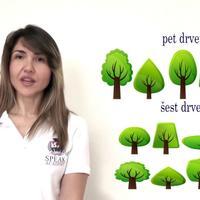Lesson 6.2 Serbian language - Numbers 1 to 10
|||числа|
||language|numbers|
Lektion 6.2 Serbische Sprache – Nummern 1 bis 10
Μάθημα 6.2 Σερβική γλώσσα - Αριθμοί 1 έως 10
Lesson 6.2 Serbian language - Numbers 1 to 10
Lección 6.2 Idioma serbio - Números del 1 al 10
Lezione 6.2 Lingua serba - Numeri da 1 a 10
Урок 6.2 Сербский язык - Цифры от 1 до 10
Lektion 6.2 Serbiska språket - siffrorna 1 till 10
Ders 6.2 Sırp dili - 1'den 10'a kadar sayılar
Osnovni brojevi
основные|
basic|numbers
Sada brojimo zajedno
|считаем|
|we count|together
Jedna olovka
one|pencil
One pen
dve olovke
|pencils
tri olovke
three|
četiri olovke
pet olovaka
|карандашей
|pencil
šest olovaka
sedam olovaka
osam olovaka
devet olovaka
deset olovaka
jedan notes
|нот
|notes
dva notesa
|ноутбука
|notebooks
tri notesa
četiri notesa
pet notesa
šest notesa
sedam notesa
osam notesa
devet notesa
deset notesa
jedno drvo
dva drveta
|trees
tri drveta
šetiri drveta
четыре|
four|
pet drveta
šest drveta
sedam drveta
osam drveta
devet drveta
deset drveta
Šta zaključujemo?
|делаем вывод
|we conclude
What do we conclude?
Imenice muškog i srednjeg roda od broja dva dobijaju nastavak -a
Nouns|masculine|||||number|||ending|
Masculine and neuter nouns of the number two receive the suffix -a
peškira, pakovanja, vitamina, notesa, drveta
полотенец|упаковки|витамина||
towel|packaging|vitamin|notebook|
towels, packaging, vitamins, notebooks, wood
Kod imenica ženskog roda situacija je malo drugačija
With feminine nouns, the situation is a little different
Kada ispred njih stoje brojevi dva, tri ili četiri dodajemo im nastavak -e
When they are preceded by the numbers two, three or four, we add the suffix -e
dve, tri četiri olovke, dve cipele, četiri čarape, tri majice
two, three, four pencils, two shoes, four socks, three T-shirts
Od broja pet do broja deset dobijaju nastavak -a
From number five to number ten they get the suffix -a
pet čarapa
|носка
|sock
šest cipela
sedam četkica
|кисточек
|brush
seven brushes
osam maramica
|салфеток
|seven
Imenice uz brojeve dva, tri ili četiri dobijaju oblik koji se zove genitiv jednine
|с|числа|||||получают||||||
||numbers||||||||||genitive|singular
Nouns with the numbers two, three or four take a form called the genitive singular
Genitiv je drugi padež u srpskom jeziku
|||case|||
The genitive is the second case in the Serbian language
Uz brojeve pet, šest, sedam, osam, devet i deset dobijaju oblik genitiva množine
|||||||||||genitive|plural genitive
With the numbers five, six, seven, eight, nine and ten, they take the form of the genitive plural
Sada je dovoljno da zapamtite samo oblike imenica uz odrežene brojeve
|||||||||cut off|
Now it is enough to remember only the forms of nouns with specific numbers
a kasnije ćemo malo opširnije raditi padeže
||we will||more extensively|discuss|cases
Da ponovimo još jednom
|let's repeat||once
Jedan mantil
|coat
dva mantila
|mantles
tri mantila
|aprons
četiri mantila
pet?
Tako je! MANTILA
That's right! COAT
jedno pakovanje
|package
one package
dva pakovanja
tri pakovanja
četiri pakovanja, pet?
pakovanja
packaging
Haljina. Upravo tako
dress|just|
Dress. Exactly
Ali to nije sve
But that's not all
Uradite sledeće primere
do|the following|examples
Do the following examples
jedna srna
|deer
one doe
pet srna
jedna mačka
|cat
one cat
pet mačaka
|cats
jedna žena
|woman
pet žena
jedna devojka
pet devojaka
|girls
Uočite pravilo
notice|rule
Notice the rule
Kada su u obliku jednine dva suglasnika jedan do drugoga
|||form|singular||consonants|one||the second
When there are two consonants next to each other in the singular form
onda se ta suglasnička grupa razbija dodavanjem jednog -a
||the|consonant|group|breaks|by adding|one|
then that consonant group is broken by adding one -a
to je a koje sada ne vidite
||||||see
it's a that you don't see now
mačka
mačAka
kocka
cube
kocAka
to cook
ali
but
lopta
ball
a ball
lopti, ne lopaAta
balls||to wash
balls, not shovels
lopta je lopta za igranje
||||playing
Lopata je alat za čišćenje snega
shovel||tool||cleaning|snow
Da li bi se radije igrali loptom ili biste čistili sneg?
||||rather|play|with the ball||you would|clean|
Would you rather play ball or shovel snow?
Broj jedan možemo zameniti neodređenom zamenicom "neki" ako se upućuje na nepoznatu osobu
number|||to replace|undefined|with a pronoun|some|||refers||unknown|person
We can replace the number one with the indefinite pronoun "some" if referring to an unknown person
Traži vas jedan čovek
is looking for|you||man
A man is looking for you
Možemo reći: Traži vas neki čovek
We can say: Some man is looking for you
Kad dve stvari idu u paru, odnosno, ne mogu jedna bez druge, onda su par
|||go||pair|that is||||||||pair
When two things go together, that is, they cannot do without each other, then they are a couple
Reč par koristimo za samo dva predmeta koja uvek idu zajedno:
word||||||the word|that|||
We use the word couple for only two objects that always go together:
par cipela
pair of shoes
par čizama
|of shoes
par čarapa
pair|
Ako su cipele rasparene, npr. dve leve ili dve desne, reći ćemo dve cipele jer one definitivno nisu par
|||torn|for example||left|||right|||||||definitely||
If the shoes are split, e.g. two left or two right, we will say two shoes because they are definitely not a pair
Ili ako imamo jednu čarapu crvene boje, drugu kivizelenu takođe nisu par - to su dve čarape
||||sock|red|color|the other|green|||||||
Or if we have one red sock, another kiwi green one is also not a pair - that's two socks
Isto važi za predmete sastavljene iz dva dela
|applies||items|assembled|||parts
The same applies to subjects composed of two parts
U nastavku im dodajemo -a
|to|||
In the following, we add -a to them
Ove imenice imaju samo množinu
||||plural
These nouns have only the plural

